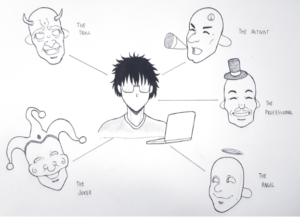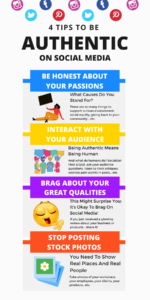Who Are We Online? A Look at Identity and Digital Personas
As we navigate the world of social media and online platforms, a fascinating question arises: Who am I, really, in the digital world? Khalil Liouane explores this concept of digital identity, suggesting that our online personas often reflect fragmented versions of ourselves. Instead of a single, cohesive identity, we become a series of digital personas, each tailored to fit the unique social and cultural dynamics of the platforms we use.
For instance, we might be highly professional on LinkedIn, more casual and creative on Instagram, and unfiltered on Twitter. Liouane suggests that these “fragments” are neither false nor fake; rather, they represent different facets of who we are.
Understanding Digital Identity as a “Mosaic”

This idea of fragmented identity can feel uncomfortable, especially if we value the idea of a “true self.” Yet, it also reflects a realistic picture of how identity works. Internal Family Systems Theory, a concept used in psychology, views a person as a sum of many “parts” or dimensions, each with different perspectives and goals. This theory aligns well with Liouane’s thoughts—our digital personas, while varied, are all part of our overall identity.
Each platform contributes to this mosaic: LinkedIn shows our professional side, Instagram our visual and artistic side, and TikTok our humorous or trendy side. While it may feel disjointed, these personas collectively form a fuller picture of who we are.
Oscar Wilde and Digital Masks — A Modern Insight
Interestingly, this concept isn’t new. Oscar Wilde famously noted, “Give a man a mask, and he will tell you the truth.” It turns out our digital “masks”—the ones with dog ears or retro VHS grain—are the real us, saying things we’d probably never say in person. Think of those unfiltered rants on Twitter or the confessional posts on Facebook. These online “masks” allow for safe self-expression in ways that real life sometimes restricts.
The Benefits of Digital Identity and Self-Expression
While a fragmented identity might sound confusing, this diversity can be beneficial. Digital platforms offer safe spaces to try on different “hats” and express various aspects of ourselves. This ability to experiment with identity can be particularly valuable for adolescents and young adults who are still forming their sense of self. Social media can serve as a testing ground where individuals explore values, beliefs, and passions in a controlled environment.

However, this fragmentation also comes with challenges. When our identities become overly shaped by platform expectations or online trends, it’s easy to feel disconnected from our “real” selves. Liouane’s work encourages us to approach digital identity with awareness, understanding that these platforms offer only a partial view of who we are.
Building a Cohesive Sense of Self Online
How, then, do we maintain a cohesive sense of self while embracing the flexibility of digital personas? Here are some guiding questions that can help us find balance:

- How does each platform allow me to express something unique about myself? Understanding what each platform brings out in us can provide insight into our values and interests.
- Why do I feel more “authentic” on certain platforms? This question can reveal what aspects of our personality feel true and comfortable and what feels performative.
- What does “authenticity” mean to me in a digital context? Recognizing our own definition of authenticity can help guide how we use digital tools while staying true to ourselves.
These questions allow us to take a more reflective approach to social media and digital identity, using online interactions as tools for personal insight and growth.
Teaching Digital Identity to High School Students: Guiding the Next Generation
Teaching high school students about digital identity provides them with tools to navigate their online presence mindfully. Here’s how educators can approach this complex subject with teens:
- Introduce Digital Identity as a “Mosaic” Concept: Encourage students to think of each online profile as a piece of their digital identity. Discuss how their Instagram, TikTok, and LinkedIn accounts show different parts of who they are. This helps them see these personas as pieces of their whole self rather than isolated, possibly confusing, fragments.
- Discuss Digital Citizenship and Online Etiquette: Help students understand the value of presenting themselves authentically online while being mindful of digital etiquette. By showing examples of positive and negative digital footprints, students can see how their online behaviour shapes their identity.
- Encourage Reflective Practices with Social Media: Provide students with journaling prompts or activities, like writing about their motivations for sharing specific content or how different platforms impact their mood and self-perception. This can be linked to Liouane’s questions, helping them critically examine how and why they present themselves in various digital spaces.
- Use Case Studies on Digital Personas and Identity Conflicts: Explore real-life examples where individuals navigated the complexities of digital identity, highlighting cases where people benefited or faced challenges due to fragmented personas.

Integrating Digital Identity in Health 9 and Math 9: Practical Examples
Health 9: Digital Identity and Online Wellness
- Outcome USC9.5: Healthy and Unhealthy Technology Use in Relationships
- Activity: Discuss how digital personas affect self-esteem and friendships. Have students evaluate a social media profile (real or fictional) and identify aspects that could impact mental health.
- Outcome USC9.7: Impact of External Influences on Identity
- Activity: Explore how peer pressure and trends shape online identities. Use role-play scenarios to help students navigate challenging digital interactions that test authenticity.
Math 9: Probability and Data Analysis with Digital Identity
- Data Analysis: Interpreting Social Media Statistics
- Activity: Use social media usage data to teach probability. Have students calculate the likelihood of encountering “authentic” profiles versus curated ones, linking statistics with digital behavior.
- Trend Analysis: Growth Patterns on Social Media
- Activity: Analyze growth rates of trends on social media, using exponential functions to show how trends shape online personas.
The Takeaway: Embrace Your Digital Mosaic
Ultimately, our digital personas reflect who we are, albeit in varied, often fragmented ways. By understanding that each online profile or post is a piece of a larger puzzle, we can appreciate the full picture these platforms create. The journey of self-discovery is ongoing, and in the digital age, it’s dynamic and multi-dimensional. Embracing our “digital mosaic” means appreciating these many facets and using them to grow into a more authentic version of ourselves—both online and offline.
Last week, we had the pleasure of hosting Wes Fryer as our guest speaker. With a rich background as a tech director and educator in tech pedagogy, Wes has led STEM education in his school division since 2013. His platforms, Show with Media and Media Literacy, offer fantastic resources for teaching students to communicate effectively through media. His school provides middle school students with computer programming and media literacy courses using specific applications—something less common in Canadian schools, where tech education often emerges at a later stage. It’s fascinating to see how early tech exposure in U.S. schools supports digital literacy, providing valuable insights into possible approaches for Canadian education.
FYI
I used ChatGPT to find witty and funny titles and to organize my writing properly. I usually copy in all the information that I prepared for this blog post and put it into the ChatGPT and ask it to make fun and witty titles.

5 Comments
Ayodele
Thanks for encouraging me to find my digital Mosaic. I agree with you that some people try to express themselves on digital platforms as opposed to physical being. For instance, I am more comfortable sharing my frustrations in a language that only a few people understand on my WhatsApp status as compared to sharing it with anybody. And my reason for doing that is just because I don’t want anybody to misunderstand whatever I say during that frustration period. Though I haven’t taught in Canada, I’m eager to apply your insights on integrating digital identity into Saskatchewan’s curriculum in my future classroom.
Reflecting on your last statement regarding early tech exposure to students in Canadian schools, I think STEM teachers need to find ways of skilling up their knowledge in this field and taking charge of the situation. It seems schools in Ontario are more versed in these fields as compared to other schools across Canadian provinces, especially Saskatchewan.
Allysia Doratti
Thank you for sharing such thoughtful reflections! I completely understand the comfort that comes from expressing certain feelings in a “safe” digital space, like using a specific language on WhatsApp to limit the audience—digital platforms truly allow us to be selective about how and with whom we share parts of ourselves. This selective sharing is a big part of what makes our “digital mosaics” so unique!
Your point about early tech exposure in Canadian schools is well taken. I agree that STEM teachers have a vital role to play in bridging the gap, especially when it comes to integrating digital skills and identity into the curriculum. Ontario’s progress in these areas can definitely serve as an inspiration for other provinces, like Saskatchewan, to bring more tech-forward opportunities into the classroom. It’s exciting to think about the ways educators like you will continue to shape this conversation and make a lasting impact!
Lisa Taylor
This was a great read Ally, as usual! I like the idea of a digital mosaic. I would suggest that we are a mosaic in our daily “face-to-face” lives as well. The way I act at work is different from my friend’s kitchen, to the rink, to my house. While I am still the same person deep down, there is a difference from place to place. We’re quick to say people are so different online, but chances are they’re different in different social settings as well.
Allysia Doratti
Thank you so much! You bring up such a great point about our “face-to-face” mosaics—it’s so true! We do naturally adapt to different settings, whether it’s at work, with friends, or at home. I love that you highlighted how these shifts in behavior aren’t exclusive to the digital world. Just like our online personas, our in-person “selves” are nuanced, with each environment bringing out unique facets of who we are.
It’s a helpful reminder that both online and offline, our identities are layered and adaptable. The digital world just amplifies this by giving us new platforms to experiment and share. Thanks for adding this perspective—it really rounds out the idea of a “mosaic” beautifully!
Wesley Fryer
Hi Allysia- Thanks so much for this thoughtful post and especially for the reflections on digital identity and sharing it with students. With my own middle schoolers this semester I am going to focus more on identity and digital identity. This is the Google Slides “identity collage assignment” I’ve been using for several semesters now and reflects some of the ideas from your post:
https://lessons.wesfryer.com/lessons/who-are-we
I really love how Dean has you all blogging and using WordPress, it’s been my go-to idea sharing platform since 2005. I definitely struggle and debate with myself when it comes to digital identity and figuring out what my “aspirational identity” is and should be. I like how you point out that using different media platforms to showcase different aspects of ourselves is not necessarily disingenuous or misleading, it is just natural, since there are different affordances to different platforms, and our identities are both complex and multifaceted.
For awhile now I’ve been attempting to reflect this on my “after page.”
https://wesfryer.com/after/
I would guess this page of links probably comes across as overwhelming to many people. But it’s part of my journey of both becoming myself, and also striving to connect with others with similar interests. It’s also a good design challenge to figure out how to try and share my complex personality as it is reflected on the social web, visually and clearly.
Best of luck to you in the semester and years to come!